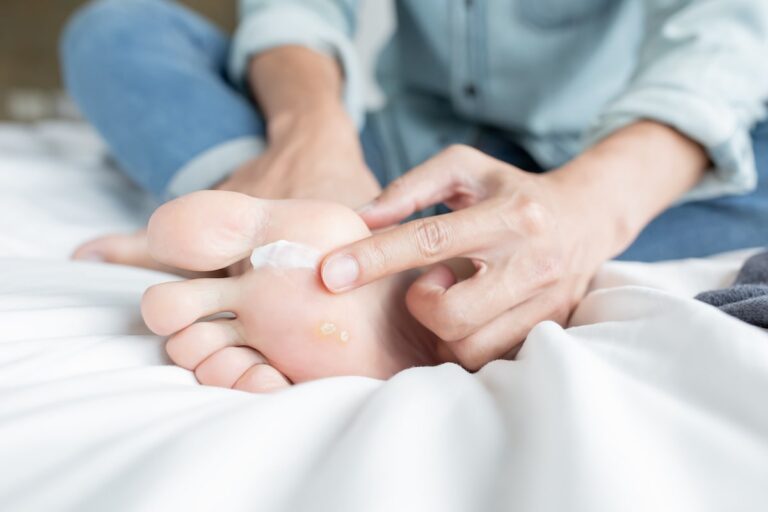
5 Great Diabetic Lotions for Dry and Itchy Skin
Diabetes affects the skin in many ways. Applying diabetic lotions helps relieve diabetic skin dryness, itchiness, and rashes.

Diabetic foot creams are often marketed as specialized products targeting the unique needs of individuals with diabetes. However, the reality is that the term “diabetic foot cream” is more of a marketing strategy rather than a reflection of a medically distinct formula.
Diabetes can lead to a range of foot-related complications, such as dry skin, ulcers, and neuropathy, each requiring specific medical treatment that a generic foot cream cannot provide. These creams might offer basic moisturizing benefits, but they are not a one-size-fits-all solution. The effectiveness of any foot cream largely depends on individual skin types and the specific foot care needs of the person with diabetes.
It’s worthwhile for individuals to experiment with different creams to find out which one works best for their specific needs. However, it’s equally important to consider the feedback and recommendations of healthcare professionals to ensure that the chosen foot care regimen aligns with their overall medical care.
But for now, let’s have a look 10 well reviewed diabetic foot creams recommended for maintaining healthy feet.
Related article

Diabetes affects the skin in many ways. Applying diabetic lotions helps relieve diabetic skin dryness, itchiness, and rashes.
Gold Bond Ultimate Diabetic Skin Relief Foot Cream is the best seller. The intensive formula provides long-lasting moisturizing effects. It’s non-greasy and absorbs very quickly. Besides, it contains Aloe Vera extract to soothe skin irritations, discomforts, and itchiness.
It’s a tremendous diabetic foot cream to use in a daily foot care routine if you don’t have any specific foot problem. Gold Bond proudly advertises that “9 out of 10 people with diabetes saw skin improvement within an hour” after using its diabetic foot cream. Worth the try!
CeraVe brand is from the L’Oréal Group and is now the #1 skincare company recommended by dermatologists in the USA. The company has formulated an excellent lotion for people with diabetes that guarantees 48-hour moisturization.
Packed with anti-oxidants, urea, and essential ceramides, this deep foot and hand moisturizer is excellent for dry, very dry, and cracked skin. It’s non-greasy, fast-absorbing, and very soothing. It’s fragrance-free, paraben-free, and non-irritating for sensitive skin.
Zatural CBD Hot Cream is the most potent and effective topical cream for diabetic foot pain caused by peripheral neuropathy (nerve damage). Cannabidiol (CBD) is one of the newest and strongest natural pain-relievers, and it works excellently on neuropathy pain.
This pain cream is infused with 2000mg of high-quality organic broad-spectrum CBD to neutralize the pain immediately. It contains more than 20 plant extracts and essential oils for neuropathy, including Helichrysum flower oil (helps regenerate damaged nerves), Basil (nerve tonic), as well as Peppermint (boosts blood circulation), Camomile, Aloe Vera (soothes), and Menthol Crystals (cooling effect).
More choices: The 10 Best Pain Creams for Neuropathy on the Feet
Warning! Peripheral neuropathy is a common yet serious diabetes complication that can lead to severe foot complications. Always ask for your doctor’s advice before applying any creams or foot care products on your feet.
Eucerin Advanced Repair foot cream is one of the most popular and doctor-recommended foot creams for people with diabetes. Its formula is highly efficient yet very gentle and suitable for sensitive skin.
It’s made to repair dehydrated, rough skins on the feet while shooting small in comfort. It’s fast-absorbing and does not leave a greasy feel which helps prevent fungus and bacteria growth.
Last but not least, it’s reasonably priced, and one tube goes a long way!
Made with premium-quality ingredients, PurOrganica Urea 40% Foot Cream is one of the most potent foot moisturizers for severely dry skin, cracked heels, rough skin, or calluses.
Also known as carbamide, Urea is a potent humectant that dissolves the intercellular matrix of the cells, promoting desquamation and softening of the skin. This cream contains 40% urea, and it’s remarkably efficient. It deeply rehydrates, nourishes, and softens the skin to get rid of and prevent any painful calluses.
It also contains Chamomille, Tea Tree, and Aloe Vera extracts, which add natural antibacterial, calming, and relaxing effects for diabetics’ irritated and itchy skins.
Due to high blood sugar levels and damaged nerves, people with diabetes tend to have poorer blood circulation and a slower healing process leading to foot infections and ulcers.
Neoteric’s new patented formula helps speed the healing process up and improves blood circulation in the feet. Plus, it’s an intense moisturizer that can help restore dry and cracked skin. The aloe vera it contains also helps soothe irritated and itchy skin. A complete diabetic foot cream combo!
Skin problems are widespread among people with diabetes. Long-term and repetitive high blood sugar levels can cause dehydration, while poor blood flow can lead to skin collagen changes. Ultimately, people living with unbalanced diabetes often suffer from severely dry skin, skin rashes, itchiness, and discomfort.
CBD Medic Medicated Ointment for Itch & Rash is a highly effective product. Its formula cleverly combines science with nature. On the scientific side, we find Allantoin and Lidocaine as active ingredients. Allantoin is a skin emollient that keeps your skin moisturized and helps prevent dryness and irritation. Lidocaine is a local anesthetic that causes numbness to relieve pain and itching caused by skin conditions.
On the nature side, we find 1% colloidal oatmeal, used to treat most skin complications from irritated skin to eczema and xerosis. There’s also a good blend of soothing and calming essential oils (Palmarosa) and Jojoba and Cottonseed oils.
Last, this ointment is infused with premium-quality CBD isolate, the purest form of Cannabidiol guaranteed without any traces of THC. Recent research on CBD has shown incredible benefits for skin conditions like itchiness, rashes, and even eczema. This is a must-try product!
Ease-Z Diabetic Foot Cream for Dry and Itchy Feet has been formulated to target the most common diabetes-related foot problems.
While it’s a good moisturizer and contains a large amount of shea butter, it also helps soothe itchiness, burning sensations, and skin discomforts.
This foot lotion contains Zinc. Zinc provides an added layer of protection for the skin and promotes the healing of sores and wounds.
Best Foot Cream for Minor Diabetic Foot Ulcers
Terrasil Diabetic ulcers and sores healing ointment has been formulated with one of the most severe diabetes complications in mind. Foot ulcers affect around 15% of people with diabetes and can lead to partial amputation if not properly taken care of.
This over-the-counter diabetic healing ointment is a great product containing activated minerals that help speed the healing process up. According to the company, it “helps minimize scarring with noticeable improvement for most diabetic ulcers in 2 days“.
Warning: Diabetic foot ulcers are severe and require medical attention. If you have a diabetic foot ulcer, seek your doctor’s advice before applying any lotion or healing ointment.
Diabetes is a condition that can seriously affect the feet. Because of high blood sugar levels that cause dehydration, people with diabetes often have dry skin. Dry skin usually cracks and peels. It’s itchy, irritated, and more prone to wounds and infections.
On top of that, more than 50% of people with diabetes have some form of peripheral neuropathy. This type of nerve damage primarily affects the feet and the lower limbs. It’s also often associated with poor blood circulation, considerably slowing the healing process.
If you have neuropathy, you may be unable to sense foot calluses, wounds, and infections. Ultimately, diabetics’ dry feet can quickly escalate to serious foot infections leading to foot ulcers, gangrene, and amputations in the worst cases.
People with diabetes must use foot creams and lotions when they have dry skin.
The feet affected by diabetes and neuropathy are very fragile. Poor-quality moisturizers and foot care products can be harmful. They often contain chemicals that are too aggressive for your skin.
The ingredients used in diabetic foot creams should be non-irritative. To prevent irritations and allergic reactions, diabetic foot creams are often fragrance-free, paraben-free, and hypoallergenic.
Diabetic foot creams are made to moisturize and soothe dry skin. Look for natural soothers and deep moisturizers such as aloe vera, urea, shea butter, oils, etc. It should also be fast-absorbing and not too greasy so as not to favor fungus and bacteria growth.
Foot creams for diabetics are also formulated to relieve mild neuropathy symptoms such as itching or burning sensation. They may provide relief from mild diabetic peripheral neuropathy symptoms and pain. However, if you suffer from severe nerve pain in the feet, you should look at pain creams for neuropathy.
A good foot moisturizer is usually enough to keep diabetic feet healthy. However, suppose your feet are affected by a specific problem such as neuropathy pain, swelling, cracked skin, blisters, ulcers, etc. In that case, you should look for foot creams specially formulated to target that problem (see the list below).
Each foot cream comes with instructions for use. As a common rule, though, diabetic foot cream should always be applied on clean and dry feet.
Remember that when living with diabetes, it is essential to gently wash your feet daily and dry them, especially between the toes, carefully. A wet or moist environment favors fungus and bacteria growth.
Once your feet are clean and dry, apply your cream or lotion and gently massage your feet, insisting on the dry or painful areas.
Avoid putting cream between the toes: keeping that area moist to avoid fungal infections is better. Putting foot cream in between your toes can cause bacterial and fungus infections. The skin of your feet must be moisturized, while the part in-between your toes must be kept dry.
Most diabetic foot creams are sold over the counter and involve minimal risk. They’re made with safe ingredients that have few and mild side effects.
The most common side effect caused by diabetic foot creams, or any creams, is an allergic reaction to one of the components. If you notice any redness, itchiness, swelling, or discomfort after applying a foot cream, immediately wash your feet to rinse them off. If it does not go away, ask for your doctor’s advice.
Feet affected by diabetes and diabetic neuropathy are very fragile. Never apply a cream or a lotion on your feet without your doctor’s advice.
Lindenweg 79 – 3084 Wabern, Switzerland